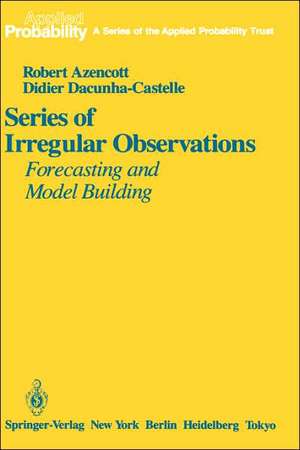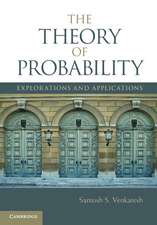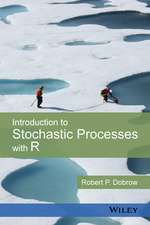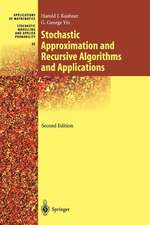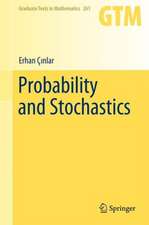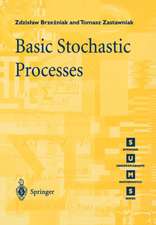Series of Irregular Observations: Forecasting and Model Building: Applied Probability, cartea 2
Autor Robert Azencott Traducere de David McHale Autor Didier Dacunha-Castelleen Limba Engleză Hardback – iun 1986
Preț: 740.85 lei
Preț vechi: 974.80 lei
-24% Nou
Puncte Express: 1111
Preț estimativ în valută:
141.76€ • 148.39$ • 117.99£
141.76€ • 148.39$ • 117.99£
Carte tipărită la comandă
Livrare economică 27 martie-02 aprilie
Preluare comenzi: 021 569.72.76
Specificații
ISBN-13: 9780387962634
ISBN-10: 0387962638
Pagini: 236
Dimensiuni: 156 x 234 x 16 mm
Greutate: 0.53 kg
Ediția:1986
Editura: Springer
Colecția Springer
Seria Applied Probability
Locul publicării:New York, NY, United States
ISBN-10: 0387962638
Pagini: 236
Dimensiuni: 156 x 234 x 16 mm
Greutate: 0.53 kg
Ediția:1986
Editura: Springer
Colecția Springer
Seria Applied Probability
Locul publicării:New York, NY, United States
Public țintă
ResearchDescriere
At
the
university
level,
in
probability
and
statistics
departments
or
electrical
engineering
departments,
this
book
contains
enough
material
for
a
graduate
course,
or
even
for
an
upper-level
undergraduate
course
if
the
asymptotic
studies
are
reduced
to
a
minimum.
The
prerequisites
for
most
of
the
chapters
(l
-
12)
are
fairly
limited:
the
elements
of
Hilbert
space
theory,
and
the
basics
of
axiomatic
probability
theory
including
L
2-spaces,
the
notions
of
distributions,
random
variables
and
bounded
measures.
The
standards
of
precision,
conciseness,
and
mathematical
rigour
which
we
have
maintained
in
this
text
are
in
clearcut
contrast
with
the
majority
of
similar
texts
on
the
subject.
The
main
advantage
of
this
choice
should
be
a
considerable
gain
of
time
for
the
noninitiated
reader,
provided
he
or
she
has
a
taste
for
mathematical
language.
On
the
other
hand,
being
fully
aware
of
the
usefulness
of
ARMA
models
for
applications,
we
present
carefully
and
in
full
detail
the
essential
algorithms
for
practical
modelling
and
identification
of
ARMA
processes.
The
experience
gained
from
several
graduate
courses
on
these
themes
(Universities
of
Paris-Sud
and
of
Paris-7)
has
shown
that
the
mathematical
material
included
here
is
sufficient
to
build
reasonable
computer
programs
of
data
analysis
by
ARMA
modelling.
To
facilitate
the
reading,
we
have
inserted
a
bibliographical
guide
at
the
end
of
each
chapter
and,
indicated
by
stars
(*
...
*),
a
few
intricate
mathematical
points
which
may
be
skipped
over
by
nonspecialists.
Cuprins
I
Discrete
Time
Random
Processes.-
1.
Random
Variables
and
Probability
Spaces.-
2.
Random
Vectors.-
3.
Random
Processes.-
4.
Second-Order
Process.-
II
Gaussian
Processes.-
1.
The
Use
(and
Misuse)
of
Gaussian
Models.-
2.
Fourier
Transform:
A
Few
Basic
Facts.-
3.
Gaussian
Random
Vectors.-
4.
Gaussian
Processes.-
III
Stationary
Processes.-
1.
Stationarity
and
Model
Building.-
2.
Strict
Stationarity
and
Second-Order
Stationarity.-
3.
Construction
of
Strictly
Stationary
Processes.-
4.
Ergodicity.-
5.
Second-Order
Stationarity:
Processes
with
Countable
Spectrum.-
IV
Forecasting
and
Stationarity.-
1.
Linear
and
Nonlinear
Forecasting.-
2.
Regular
Processes
and
Singular
Processes.-
3.
Regular
Stationary
Processes
and
Innovation.-
4.
Prediction
Based
on
a
Finite
Number
of
Observations.-
5.
Complements
on
Isometries.-
V
Random
Fields
and
Stochastic
Integrals.-
1.
Random
Measures
with
Finite
Support.-
2.
Uncorrected
Random
Fields.-
3.
Stochastic
Integrals.-
VI
Spectral
Representation
of
Stationary
Processes.-
1.
Processes
with
Finite
Spectrum.-
2.
Spectral
Measures.-
3.
Spectral
Decomposition.-
VII
Linear
Filters.-
1.
Often
Used
Linear
Filters.-
2.
Multiplication
of
a
Random
Field
by
a
Function.-
3.
Response
Functions
and
Linear
Filters.-
4.
Applications
to
Linear
Representations.-
5.
Characterization
of
Linear
Filters
as
Operators.-
VIII
ARMA
Processes
and
Processes
with
Rational
Spectrum.-
1.
ARMA
Processes.-
2.
Regular
and
Singular
Parts
of
an
ARMA
Process.-
3.
Construction
of
ARMA
Processes.-
4.
Processes
with
Rational
Spectrum.-
5.
Innovation
for
Processes
with
Rational
Spectrum.-
IX
Nonstationary
ARMA
Processes
and
Forecasting.-
1.
Nonstationary
ARMA
Models.-
2.
Linear
Forecasting
and
Processes
with
Rational
Spectrum.-
3.
Time
Inversion
and
Estimation
of
Past
Observations.-
4.
Forecasting
and
Nonstationary
ARMA
Processes.-
X
Empirical
Estimators
and
Periodograms.-
1.
Empirical
Estimation.-
2.
Periodograms.-
3.
Asymptotic
Normality
and
Periodogram.-
4.
Asymptotic
Normality
of
Empirical
Estimators.-
5.
The
Toeplitz
Asymptotic
Homomorphism.-
XI
Empirical
Estimation
of
the
Parameters
for
ARMA
Processes
with
Rational
Spectrum.-
1.
Empirical
Estimation
and
Efficient
Estimation.-
2.
Computation
of
the
ak
and
Yule-Walker
Equations.-
3.
Computation
of
the
bl
and
of
?2.-
4.
Empirical
Estimation
of
the
Parameters
When
p,
q
are
Known.-
5.
Characterization
of
p
and
q.-
6.
Empirical
Estimation
of
d
for
an
ARIMA
(p,d,q)
Model.-
7.
Empirical
Estimation
of
(p,q).-
8.
Complement:
A
Direct
Method
of
Computation
for
the
bk.-
9.
The
ARMA
Models
with
Seasonal
Effects.-
10.
A
Technical
Result:
Characterization
of
Minimal
Recursive
Identities.-
11.
Empirical
Estimation
and
Identification.-
XII
Effecient
Estimation
for
the
Parameters
of
a
Process
with
Rational
Spectrum.-
1.
Maximum
Likelihood.-
2.
The
Box-Jenkins
Method
to
Compute
(ã,
b).-
3.
Computation
of
the
Information
Matrix.-
4.
Convergence
of
the
Backforecasting
Algorithm.-
XIII
Asymptotic
Maximum
Likelihood.-
1.
Approximate
Log-Likelihood.-
2.
Kullback
Information.-
3.
Convergence
of
Maximum
Likelihood
Estimators.-
4.
Asymptotic
Normality
and
Efficiency.-
XIV
Identification
and
Compensated
Likelihood.-
1.
Identification.-
2.
Parametrization.-
3.
Compensated
Likelihood.-
4.
Mathematical
Study
of
Compensated
Likelihood.-
5.
Noninjective
Parametrization.-
6.
Almost
Sure
Bounds
for
the
Maximal
Log-Likelihood.-
7.
Law
of
the
Interated
Logarithm
for
the
Periodogram.-
XV
A
Few
Problems
not
Studied
Here.-
1.
Tests
of
Fit
for
ARMA
Models.-
2.
Nonlinearity.
